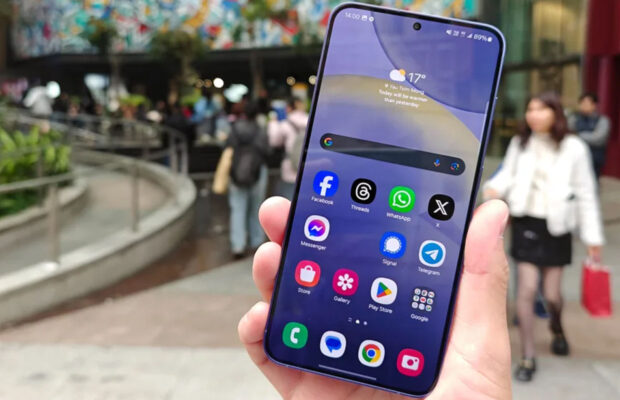Samsung Galaxy S24 & S24+ Review: A Taste Of Generative AI In Everyday Use

For its first phones of 2024, Samsung focused so much on its “Galaxy AI” features that, physically, the Galaxy S24 series doesn’t appear to be much different than the S23. Once again, the company’s phones aren’t different enough to justify upgrading from their predecessors, especially knowing that the S23 series, Z Fold 5, Z Flip 5 and Tab S9 will be getting at least some of these AI features later this year. There’s also competition from the Google Pixel 8 series, which offer many of the same new features from a more established AI company.
Still, that doesn’t mean we should dismiss the Galaxy S24 series altogether. Samsung’s AI efforts may be an indicator of smartphone features to come. Even when compared to the Pixel 8s, Samsung’s Galaxy AI has its perks, particularly with real-time translation in voice calls and the option to change the tone of your writing. In places where Google’s Pixel is not available, Samsung has an opportunity to capture an audience that’s curious about generative AI on phones. The question is: has Samsung done a good job at integrating these AI tools into its smartphone line?
Design & Display
Software
I spent most of my time with my S24+ testing its “Galaxy AI,” which is touted as a privacy-first AI suite powered by the neural processing unit inside the Snapdragon 8 Gen 3 chip. In other words, these phones can run some of their “advanced intelligence” tasks on device, and there’s an option to go completely offline for added privacy, but the results may not be as good or as up to date. On a related note, Samsung promises to never use your data “for machine learning or for targeting ads,” and that “your data is immediately deleted from our servers or our partner’s servers as soon as generation is complete.”
Samsung’s Galaxy AI can be broken down into six functions: “live translate” for voice calls, live interpreter (for in-person conversations), writing assist from the keyboard (for quick translations and changing the tone of your drafts), note assist (for auto summarization and formatting), transcript assist (with translations of your recordings) and generative edit in the gallery app. The translation features rely on Samsung’s own language packs, which currently include English (US and UK), Chinese (Mandarin), French, German, Hindi, Italian, Japanese, Korean, Polish, Portuguese, Spanish (Mexico, Spain and US), Thai and Vietnamese. The company promised that more will be added later.
Before we go further, I’d like to point out that it wasn’t immediately clear where I could enable these AI features. They are disabled by default, and there’s no single switch to enable them all in one go. It took me a while before I dug up the “advanced intelligence” hub in system settings. Even for Google’s self-explanatory “Circle to Search,” I had to go through multiple settings pages to enable it.
The most prominent Galaxy AI feature is perhaps the real-time two-way translation for voice calls, which Samsung has been pitching since November. I had to first enable live translate in the dialer app’s settings, where I had to set the languages of myself and the receiver (it’s easier if you install the necessary language packs in the “advanced intelligence” hub beforehand). Then when you eventually make the phone call, you’ll also need to tap on the “call assist” button, and then tap the “live translate” button to start.
This took me a few runs before I realized I had to hit both buttons to get this thing going, at which point the live translate tool would broadcast a prompt declaring that the call is being translated and live-captioned. Speaking of, be warned that the phone app doesn’t save these transcripts afterwards (I found out the hard way), so be sure to take screenshots or jot down important info before you hang up.
Performance & Battery
Like the S24 Ultra, the S24 and S24+ are powered by Qualcomm’s Snapdragon 8 Gen 3 processor — but only in the US, South Korea and China. If you’re buying one in the UK, then you’ll have to make do with the Samsung Exynos 2400, though benchmarks have indicated that its performance isn’t far off from Qualcomm’s counterpart and, on paper, it actually has a faster 5G modem. As for options, the S24 starts with 8GB of RAM and 128GB of storage for its $800 base model, whereas the S24+ starts with 12GB of RAM and twice the storage at $1,000.
I’ve yet to run into any hiccups on either device, and the slick Android 14 animations made switching from one app to another feel effortless. On Geekbench 6, the S24 and S24+ saw notable improvements in CPU multi-core performance scores, reaching 7,049 and 6,641, respectively. Both models saw a bigger boost in GPU scores, up to 15,082 and 14,982, respectively.
The S23+ already impressed us with its 25-hour result on our video rundown battery test last year. This time, the S24+ lasted for 25 hours and 50 minutes, beating its predecessor by almost an hour. The smaller S24 didn’t disappoint, either, clocking in at about 24.5 hours, so battery life isn’t an issue if single-handed operation matters to you. The S24+’s battery life is even more generous in the real world: With the occasional Facebook, Messenger, WhatsApp, Instagram, YouTube and camera testing throughout the day, I still often ended up with 50 to 60 percent of power by the time I got home in the evening. If I forgot to charge the phone overnight, it could still last another day.
Wrap-Up
I began my review of the S24 and S24+ with low expectations. After all, they weren’t very different (visibly) than their predecessors. But as I spent more time with these devices, their minimalist design and slick UX grew on me. Then came the built-in generative AI features, which are more convenient and intuitive than most other third-party bots. There’s even greater potential with the live translation tools, especially with international travel basically back to pre-pandemic levels. The new software aids, combined with subtle design tweaks, help the S24 and S24+ make a more compelling case for upgrading from an S22 or earlier models. Or switching over from other brands, for that matter.
Even though OpenAI and Google are already well ahead in the generative AI game, Samsung still deserves some credit for simplifying these functions — at least while it keeps offering Galaxy AI for free until the end of 2025. For now, though, Samsung needs to find a way to polish the whole package, and make some of the AI features more easily accessible. More importantly, users should be offered an option to save the transcripts after each translated phone call or in-person chat. I’m sure Samsung would rather not have Galaxy AI be reduced to a channel for venting.













 © 2024
© 2024
0 comments